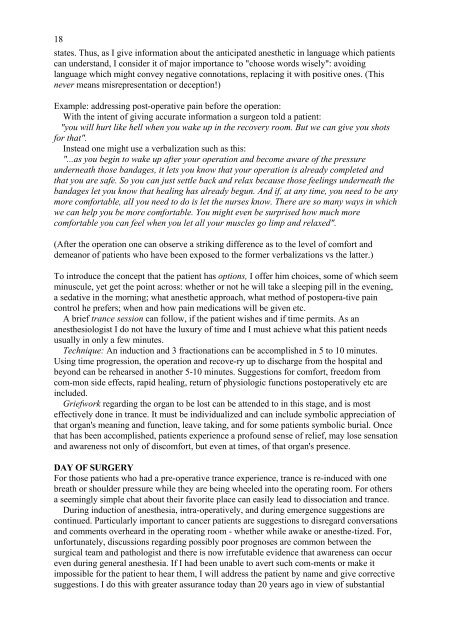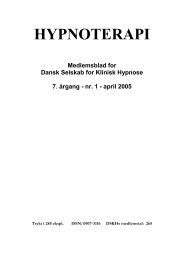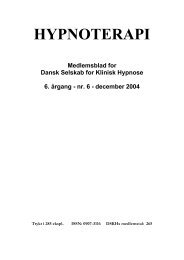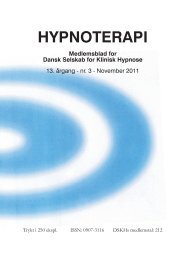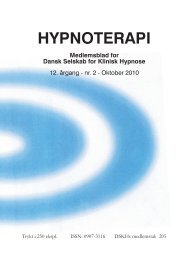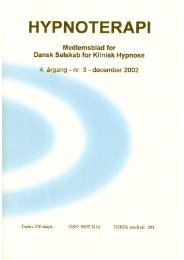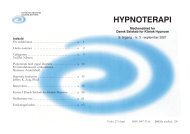HYPNOTERAPl - Dansk Selskab for Klinisk Hypnose
HYPNOTERAPl - Dansk Selskab for Klinisk Hypnose
HYPNOTERAPl - Dansk Selskab for Klinisk Hypnose
Create successful ePaper yourself
Turn your PDF publications into a flip-book with our unique Google optimized e-Paper software.
18<br />
states. Thus, as I give in<strong>for</strong>mation about the anticipated anesthetic in language which patients<br />
can understand, I consider it of major importance to "choose words wisely": avoiding<br />
language which might convey negative connotations, replacing it with positive ones. (This<br />
never means misrepresentation or deception!)<br />
Example: addressing post-operative pain be<strong>for</strong>e the operation:<br />
With the intent of giving accurate in<strong>for</strong>mation a surgeon told a patient:<br />
"you will hurt like hell when you wake up in the recovery room. But we can give you shots<br />
<strong>for</strong> that".<br />
Instead one might use a verbalization such as this:<br />
"...as you begin to wake up after your operation and become aware of the pressure<br />
underneath those bandages, it lets you know that your operation is already completed and<br />
that you are safe. So you can just settle back and relax because those feelings underneath the<br />
bandages let you know that healing has already begun. And if, at any time, you need to be any<br />
more com<strong>for</strong>table, alI you need to do is let the nurses know. There are so many ways in which<br />
we can help you be more com<strong>for</strong>table. You might even be surprised how much more<br />
com<strong>for</strong>table you can feel when you let all your muscles go limp and relaxed".<br />
(After the operation one can observe a striking difference as to the level of com<strong>for</strong>t and<br />
demeanor of patients who have been exposed to the <strong>for</strong>mer verbalizations vs the latter.)<br />
To introduce the concept that the patient has options, I offer him choices, some of which seem<br />
minuscule, yet get the point across: whether or not he will take a sleeping pill in the evening,<br />
a sedative in the morning; what anesthetic approach, what method of postopera-tive pain<br />
control he prefers; when and how pain medications will be given etc.<br />
A brief trance session can follow, if the patient wishes and if time permits. As an<br />
anesthesiologist I do not have the luxury of time and I must achieve what this patient needs<br />
usually in only a few minutes.<br />
Technique: An induction and 3 fractionations can be accomplished in 5 to 10 minutes.<br />
Using time progression, the operation and recove-ry up to discharge from the hospital and<br />
beyond can be rehearsed in another 5-10 minutes. Suggestions <strong>for</strong> com<strong>for</strong>t, freedom from<br />
com-mon side effects, rapid healing, return of physiologic functions postoperatively etc are<br />
included.<br />
Griefwork regarding the organ to be lost can be attended to in this stage, and is most<br />
effectively done in trance. It must be individualized and can include symbolic appreciation of<br />
that organ's meaning and function, leave taking, and <strong>for</strong> some patients symbolic burial. Once<br />
that has been accomplished, patients experience a profound sense of relief, may lose sensation<br />
and awareness not only of discom<strong>for</strong>t, but even at times, of that organ's presence.<br />
DAY OF SURGERY<br />
For those patients who had a pre-operative trance experience, trance is re-induced with one<br />
breath or shoulder pressure while they are being wheeled into the operating room. For others<br />
a seemingly simple chat about their favorite place can easily lead to dissociation and trance.<br />
During induction of anesthesia, intra-operatively, and during emergence suggestions are<br />
continued. Particularly important to cancer patients are suggestions to disregard conversations<br />
and comments overheard in the operating room - whether while awake or anesthe-tized. For,<br />
un<strong>for</strong>tunately, discussions regarding possibly poor prognoses are common between the<br />
surgical team and pathologist and there is now irrefutable evidence that awareness can occur<br />
even during general anesthesia. If I had been unable to avert such com-ments or make it<br />
impossible <strong>for</strong> the patient to hear them, I will address the patient by name and give corrective<br />
suggestions. I do this with greater assurance today than 20 years ago in view of substantial


